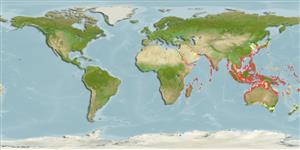Common names from other countries
Environment: milieu / climate zone / depth range / distribution range
экология
; пределы глубины 0 - 40 m (Ref. 349). Tropical
Indo-West Pacific: from East Africa, to Melanesia; north to Japan, and south to northern Queensland and New Caledonia. Apparently rare in Australia.
Length at first maturity / Size / Вес / Возраст
Maturity: Lm ? range ? - ? cm Max length : 28.0 cm SHL самец/пол неопределен; (Ref. 349); common length : 20.0 cm SHL самец/пол неопределен; (Ref. 349)
Collected for food and for the large, heavy shell in many areas. Mature shell is traditionally used as a trumpet when the tip of the spire is cut off (Ref. 349). Common on inner reef flats and in shallow water near rocky areas, but frequent also offshore. Occurs at the low tide mark. Fasciolariidae are active predators, feeding on tube worms, vermetid and other molluscs (Ref. 349).
Life cycle and mating behavior
половая зрелость | размножение | нерест | икра | Fecundity | личинки
This species is a non-broadcast spawner. Life cycle does not include trocophore stage. Also Ref. 833.
Основная ссылка
ссылки | координатор | соавторы
Poutiers, J.M. 1998. (Ref. 349)
Статус Красного Списка МСОП (Ref. 130435)
Статус СИТЕС (Ref. 108899)
Not Evaluated
Not Evaluated
Угроза для людей
Harmless
Использование человеком
рыболовство: коммерческий
| FishSource |
инструменты
дополнительная информация
Возраст/РазмерыростЗависимость между длиной и массой телаЗависимость между длинамиморфологияличинкичисленность
ресурсы в Интернет
Estimates based on models
Preferred temperature
(Ref.
115969): 24.1 - 29.1, mean 28.1 (based on 1234 cells).
Уязвимость
Low vulnerability (18 of 100).
Категория цены
Unknown.
